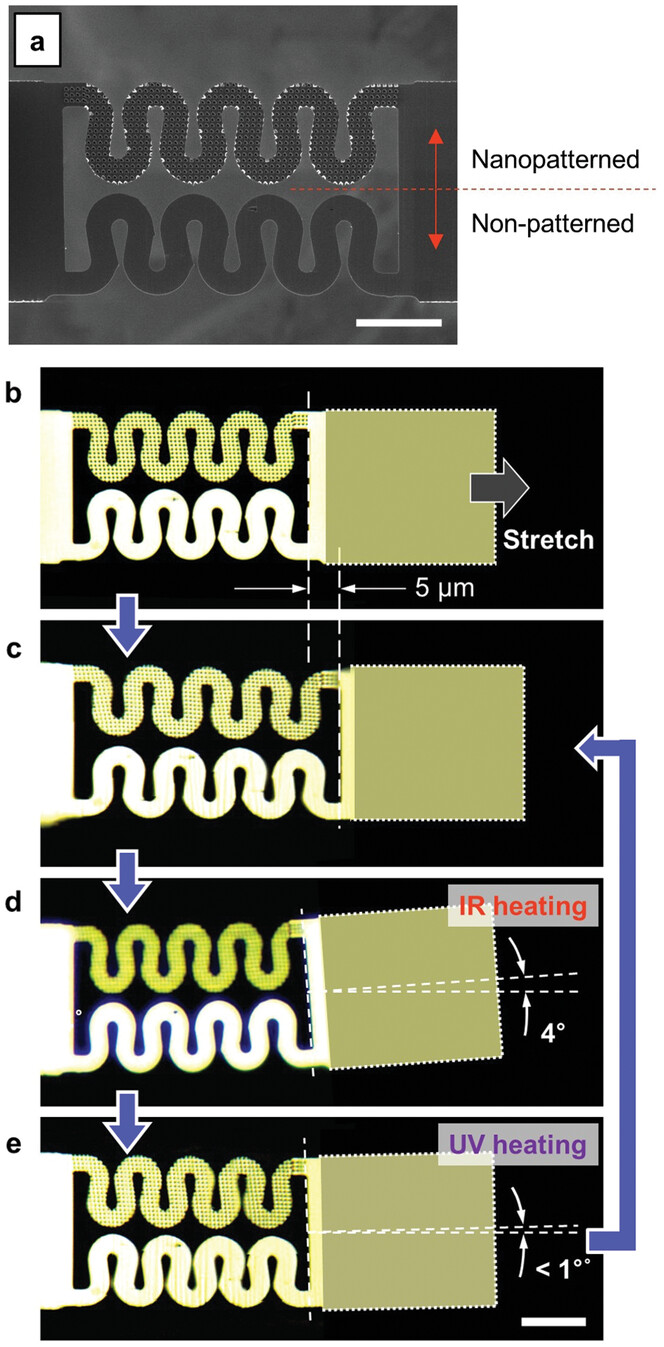Research News
[Prof. Sung-Hoon Ahn, Prof. Heui Jae Pahk] Surface Nanopatterned Shape Memory Alloy (SMA)-Based Photosensitive Artificial Muscl
Author
김민아
Date
2024-04-29
Views
144
Abstract
Light-driven shape memory alloy (SMA)-based microscale actuators show great promise for artificial muscle and biomedical applications, as they are actuated remotely and have a fast response speed. However, ultraviolet (UV) light is required for device actuation; thus, the operating environment has been limited. Here, an infrared (IR) light-driven SMA actuator is proposed, in which the plasmonic effect is used to enhance IR light absorptance. A sub-micrometer pattern is used to create an optical meta-surface capable of tuning the light absorptance. Conical nanohole arrays are fabricated with a focused ion beam. The absorptance tuning effect is evaluated in terms of the optical characteristics and performance of the actuator. The nanopatterned surface increases the narrow-band IR light absorption by up to 55%. Optics simulations are conducted to verify the experimental results. A pattern design method is proposed, based on the light wavelength of the stimulating source. Combining heterogeneous surfaces, both UV and IR light achieve decoupled microscale actuation. These actuators show a response similar to that of the iris muscle, which is responsible for the eye's pupillary reflex. It is expected that these actuators will broaden SMA applications in clinical devices and soft robotics.

Conclusion
In summary, we demonstrated the concept of a photosensitive microscale SMA actuator that enhances visible and IR light absorptance via a nanopattern plasmonic effect. The main goal of this research was to apply a simple nanopattern not only to develop a biocompatible heating method but also to implement microscale asymmetric motion. Unlike the color filter method, this concept does not require the use of two or more materials, so delamination is much less problematic. In addition, the localized plasmonic effect enables absorptance tuning over a small area. In terms of manufacturing, the FIB process is a flexible, single-step fabrication method for creating localized patterns without a mask; the actuator and pattern design can be customized for the desired effect. In this research, to evaluate and improve the effect of the nanopatterns, the nanohole geometry and optical properties were analyzed experimentally and numerically. The nanohole diameter was one of the main parameters to obtain a significant absorptance difference. In addition, FDTD simulation results showed that the pattern period can be customized for a particular wavelength having a high absorptance. Finally, the actuation strain verified the plasmonic effect on the photothermal actuator. In addition, a combination of heterogeneous surfaces was used to demonstrate sequential microscale motion as a response to IR and UV laser heating.Our actuator design shows great potential for use as an actuation source for artificial muscles and/or in combination with other built-in sensors and processes. Based on the improvement of the manufacturing process to pattern in higher resolution, using various wavelength lasers can achieve the advanced programmable actuator demonstrating complicated motion. In addition, although photo-sensitive actuation was performed by using high-temperature nitinol in this research, this concept can be applied to nitinol with a low actuation temperature (35–40 °C). The biocompatibility and high energy density properties of nitinol along with the developed optical meta-surface, broaden the applications of photothermal SMA actuators in biomedical platforms, to encompass minimally invasive surgery end effectors and microrobots. Furthermore, we expect that the developed photo-sensitive actuator contributes to implementing intelligent machines having combined functions of sensing, decision-making, controlling, and acting.[2, 22, 27]
More Information : Surface Nanopatterned Shape Memory Alloy (SMA)‐Based Photosensitive Artificial Muscle - Kim - 2022 - Advanced Optical Materials - Wiley Online Library

